Grafting on Pereskiopsis
Grafting can be useful in several ways:
- It increases growth speed significantly; a seedling can grow to a full flowering plant in just 6-7 months.
- In some cases interesting seedlings appear; such as those lacking chlorophyll (often pink or yellow).
These will not survive on their own roots, but grafting them can allow them to survive.
- Maybe one of your cacti has been attacked by critters, fungi, or other damaging things. In such cases one
can reproduce by grafting even single areoles.
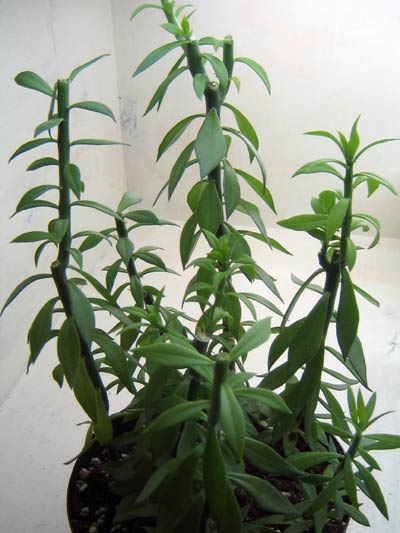
Pereskiopsis Spathulata
When grafting on "fat" stock, such as Hylocereus, Trichocereus or Myrtillocactus, some kind of fixture
will usually be necessary to make the scion stick to the stock (typically rubber-band). This is not the case when
grafting on Pereskiopsis. Pereskiopsis is a fast growing type of cacti, pencil-thick, has leaves and therefore
doesnt look like typical cacti. They are easy to propagate by cuttings, and grow like weeds. A cutting will typically
root within 7-10 days. Cuttings can in many cases be planted as you sow the seeds, and you are ready to go in 3 weeks or so.
Some terminology:
- Stock - the plant you graft ON, in this case Pereskiopsis
- Scion - the plant you put on the top of the stock, in this case the seedling
Here is a list of things you will need to get started:
- A *sharp* scalpel. Many prefer using razor-blades, but those are not very common in many places anymore.
I always use new blades. The blades must be cleaned after a cut is done, using alcohol (or similar). If you
have no such things around, I have also sucessfully cleaned them with a moist cloth, wrapped the blade in
tin-foil (to avoid soot) and heating it a bit using a lighter.
- Rooted Pereskiopsis. Ideally the stem should be around 10cm (4 inches) or more, shorter will also work.
- A transparent plastic box or tent, the grafts must be placed in high humidity for around 6-7 days.
- Pincette, tweezers, or similar to deal with the seedlings.
- A clean surface to do the seedling-surgery, i.e. a plastic-cover or similar
Before you start doing surgery, there are some important points that MUST be observed:
- Vascular ring alignment. No matter what kind of scion/stock you use, the vascular rings must overlap in
some way or your graft will fail, as illustrated:
BAD
 |
GOOD
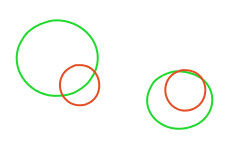 |
As we will be working on tiny seedlings, the vascular rings can be difficult to spot. Therefore, simply put the
seedlings a little off-center on the stock.
-
After putting the seedling onto the stock, quickly put the fresh graft into a humid environment. This is not
necessary for the common fat-stock grafts, but on Pereskiopsis you are guarranteed to fail if you omit this.
In dry air the Pereskiopsis will shrivel up and reject the scion. I use a transparent plastic-box,
and put a vessel with water inside to increase humidity (see picture below).
So, since we are now done with dry theory, lets get into the surgery:
- Slice the top off the Pereskiopsis, around 1.5cm (½ inch) will usually get you to the place where the diameter is
fine. Make sure the cut is plain!
- Pick your favourite seedling, make sure it is clean (some people wash them in alcohol, but I found that unnecessary).
Put it on a clean surface, and slice it easily around the middle.
The seedling should stick on the blade:
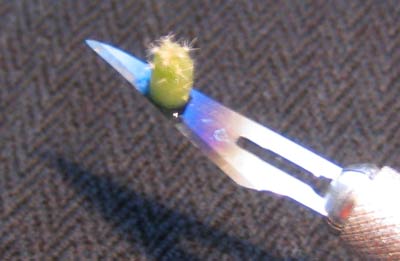
- Use a match, pincette (tweezers) or similar and transfer the seedling to the Pereskiopsis. When the seedling rests
on the stock, a little off-center, gently push it a little from top to remove eventual air-bubbles.
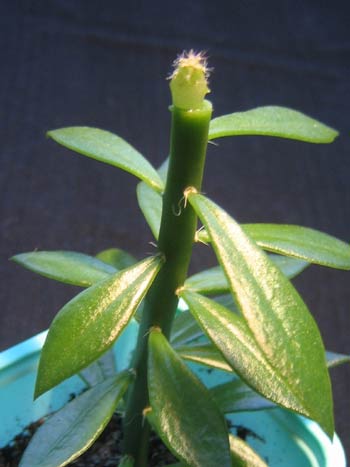
- Quickly move the fresh graft into your humidity-chamber! (Note: The plastic-box to the left, containing water.)
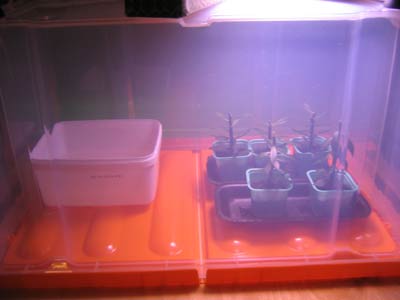
The grafts should be kept in humidity for around 7 days. This may lead to worries about fungal attack etc., but I have never
had that problem. Also, the remains of the top of the Pereskiopsis can be re-rooted. Let it dry for a few hours, repot it in
moist soil and you will have new stock within a few weeks.
After taking them out of the chamber, place them under your growlights. If the graft is successful, it should start
growing soon depending on the species you grafted. For some species it can take a week before you see anything. Some
types may take 2-3 weeks.
Important: When you wait for the scion to start growing, the pereskiopsis will very often start to put out new
branches. It is important that you remove these (preferably with a scalpel or similar, without hurting the leaves),
or the stock will spend its energy on growing the new branches instead of pumping up the scion.
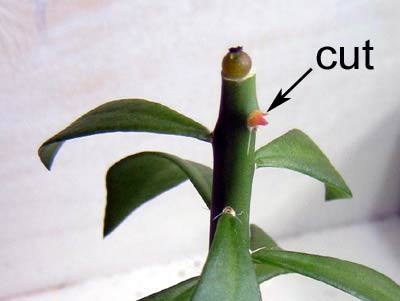
You are probably curious about the results. Here are a few pictures:
These are Echinopsis subdenudatum, around 3-4 weeks after they were taken out of the humidity-chamber. Note the
difference with seedlings on the right, from the same batch. (The bottom-right seems to be crested, a mutation not uncommon.)
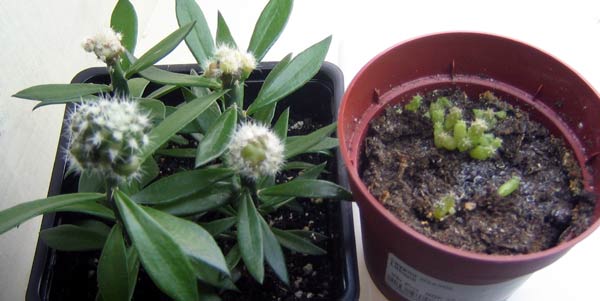
Echinopsis lagenformis, and seedlings from the same batch to the right:
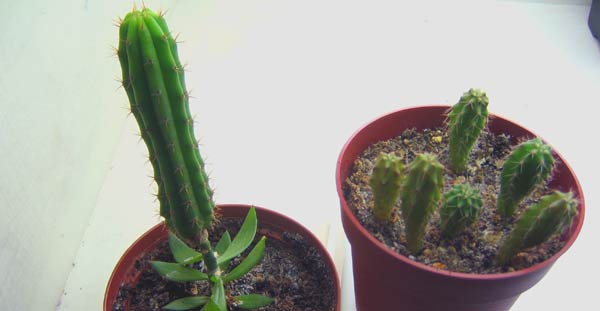
Author: Oyvind Idland, Norway
Text and photo © Oyvind Idland 2006
|